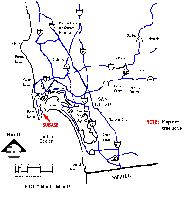
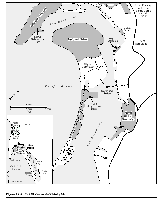
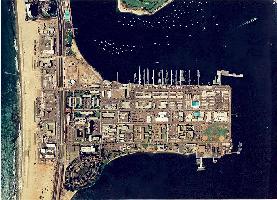

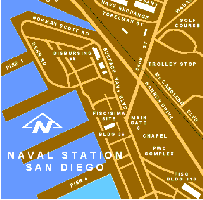
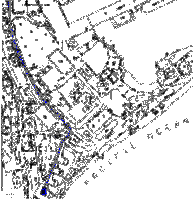



Naval Air Station North Island (NASNI) is part of the largest aerospace-industrial complex in the Navy. It includes Naval Amphibious Base Coronado, Outlying Field Imperial Beach and Naval Air Landing Facility, San Clemente Island. The complex's 5000 acres in San Diego and 130 commands bracket the city of Coronado from the entrance to San Diego Bay to the Mexican border. North Island itself is host to 23 squadrons and 75 additional tenant commands and activities, one of which, the Naval Aviation Depot, is the largest aerospace employer in San Diego. Its airfield has over 235 aircraft and its quay wall is home port to two aircraft carriers, USS Constellation (CV 64) and USS John C. Stennis (CVN 74), America�s newest nuclear powered carrier.
Only seven years after the Wright Brother's first flight, a Curtis airplane landed on North Island. That same year, 1910, North Island became the birthplace of naval aviation when Navy Lieutenant Theodore Ellyson transferred here to receive flight instruction from the Curtis Aviation Camp. Seven years later, the Naval Air Station, North Island, was established.
North Island is headquarters for six major military flag staffs including: Commander Naval Air Force, US Pacific Fleet, responsible for maintenance and training of all naval aircraft and aircraft carriers in the Pacific Fleet, Commander Third Fleet, responsible for the defense of the western approaches to the US and the direction of joint, combined, intertype and fleet exercises in the eastern Pacific, Commanders Carrier Group One and Seven and Commanders Cruiser Destroyer Group One and Five. Additionally, the base is home to the Navy's only Deep Submergence Rescue Vehicles, Mystic (DSRV 1) and Avalon (DSRV 2). The DSRV motor vessel support ships is also homeported here. With all the ships in port, the population of the base is over 30,000 active duty, selected reserve military and civilian personnel.
The Navy Submarine Support Facility was established in November 1963, on 280 acres of the land. On November 27, 1974 the base was re-designated a shore command, serving assigned submarines, Submarine Group Five, Submarine Squadrons Three and Eleven, Submarine Development Group One, and Submarine Training Facility. On October 1, 1981 the base was designated as Naval Submarine Base. Starting in April 1995, several commands were decommissioned or their homeports were changed, to meet the down-sizing requirements of the Navy. Commands throughout San Diego were regionalized in an effort to provide services while managing a reduced budget. Current tenant commands include COMSUBRON ELEVEN, COMSUBDEVRON FIVE, Submarine Training Center Pacific (SUBTRAFAC), 7 submarines, a submarine tender (USS MCKEE), one dry dock (ARCO), and the Navy's Substance Abuse Rehabilitation Department (SARD). The Naval Amphibious Base (NAB) Coronado is located just across tha bay from San Diego, CA. The base is situated on the Silver Strand, between the San Diego Bay and the Pacific Ocean. NAB Coronado is a major shore command, supporting 27 tenant commands, and is the West Coast focal point for special and expeditionary warfare training and operations. The amphibious base houses Commander Naval Surface Force, US Pacific Fleet, responsible for the training, maintenance and crews of the approximately 90 ships of the Pacific Fleet and Commander Naval Special Warfare Command, US Pacific Fleet. Also located there are most of the Naval Expeditionary and Naval Special Warfare units of the Pacific Fleet as well as the famed Navy Parachute Team, the Leap Frogs.The Navy has established a Pacific Fleet Force Structure consisting of six aircraft carriers. Home port capabilities for five of these vessels have been established at Navy installations in the continental United States. Home port facilities and infrastructure for two conventionally powered carriers (CV) and one nuclear powered carrier (CVN) currently exist at Naval Air Station North Island (NASNI), Coronado, California; home port facilities and infrastructure for one CVN exist at Naval Station Everett (NAVSTA Everett), Washington; and home port facilities and infrastructure for one CVN exist at Puget Sound Naval Shipyard (PSNS), Bremerton, Washington. Facilities and infrastructure exist in Japan to accommodate a forward-deployed CV. As aging CVs reach the end of their service life and are replaced by CVNs, the Navy has a need to create the capacity to home port these new CVN assets. The U.S. Pacific fleet is currently undertaking the replacement of two such CVs within the U.S. Pacific Fleet area of responsibility (AOR). Of the six aircraft carriers homeported in the U.S. Pacific Fleet, three are currently NIMITZ-class CVNs. The CVN is a newer class of aircraft carrier requiring different homeporting shore infrastructure (e.g., electrical power and water depth).
In July 1999 the Navy completed a Final Environmental Impact Statement (EIS) designed to determine the appropriate homeports for three Nimitz-class nuclear-powered aircraft carriers in the Pacific Fleet. The EIS process is required by the National Environmental Policy Act (NEPA). The in-depth EIS process began in December 1996. Following public meetings held in communities at each of the four alternate locations in February 1997, the Navy spent more than 18 months examining the ports to determine how well they satisfied the CVN Homeporting Objectives and Requirements as they pertain to Operations and Training; Facilities and Infrastructure; Maintenance; and Quality of Life. The study also analyzed the potential environmental effects for each of the alternatives considered. In August 1998, a Draft EIS was released for public review.
The Navy�s preferred alternative is to upgrade the current facilities and infrastructure at NASNI (which has the homeport capacity to support one CVN and two CVs) with the additional capacity required to support a total of three CVNs and would maintain the existing CVN homeport capacity at NAVSTA Everett. The Navy�s preference for this home port combination is based on NASNI�s accessibility to the sea and training ranges; PHNSY�s inaccessibility to training ranges and the lack of facilities to support a carrier air wing; and the operational and quality of life advantages of the existing CVN home port at NAVSTA Everett and the assumption that depot maintenance for that CVN can be successfully completed without a significant adverse impact on crew quality of life or maintenance schedules and costs.
The transient berth at NASNI provides direct land access from the ship berth to an airfield for air wing logistic support, including aircraft onloads and offloads for Pacific Northwest homeported CVNs. The majority of the CVNs' underway training is off southern California (SOCAL) and the only carrier access to a West Coast airfield is at NASNI. Therefore, it is essential that transient CVNs remain able to moor temporarily at NASNI to load and off-load their air wing.





